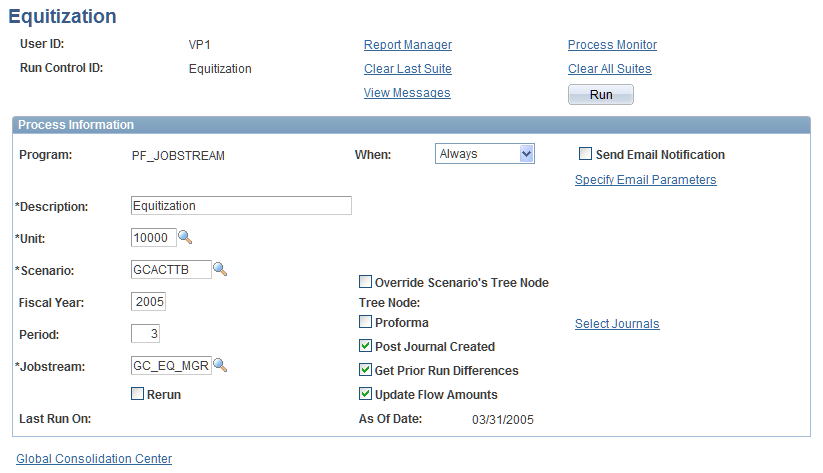Processing Equitization
This section provides an overview of equitization processing and discusses how to run the Equitization application engine.
Pages Used to Process Equitization
|
Page Name |
Definition Name |
Navigation |
Usage |
|---|---|---|---|
|
Equitization run control |
RUN_GC_EQTZ |
|
Run the Equitization application engine. |
|
Journal Selection |
RUN_GC_JRNL |
Click the Select Journals link on the Equitization run control page. |
Select which journals to include when using the Proforma option. |
Understanding Equitization Processing
If you have set up equitization groups for your consolidation model, use the Equitization run control page to equitize the current period changes in equity (for example, net income) of subsidiaries.
When processing equitization, the system completes these steps for each ChartField value in the equitization rule group:
Resolves data from the consolidation ledger (CLED) into the ILOG, based on the equitization rule group for the consolidation model, the fiscal year, and the period that you specify in the run control, and adds a sequence number key to each row.
Debits the ownership percentage amount for the account of the subsidiary against the parent investment account of the parent (if the control percentage is greater than the threshold), and credits the ownership percentage amount for the account of the subsidiary against the investment offset of the parent, and then moves the data to the OLOG.
These entries, which increase the parent investment account and increase parent earnings, are booked directly against the parent. Optionally, the system eliminates the amount equitized against the elimination entity (if you define the eliminate equitizations fields for the rule). For financial statement format ledgers, the system creates offset balance entries for the income statement side, similar to the investment offset entries.
Offsets the total equitized source amount to the equitization summary account specified in the rule by debiting the equitization offset account for the subsidiary and crediting the equitization summary, and then moves the data to the OLOG.
These entries are booked against the subsidiary. (This is an optional step, completed only if defined on the Equitization - Subsidiary Offset page.)
Generates non-controlling interest adjustments for claims on the subsidiary's net income for the period.
For trial balance format ledgers, the system debits the non-controlling interest expense account and credits the non-controlling interest liability account. For financial statement format ledgers, only the expense entries are created. The entries are booked to the elimination entity.
For financial statement format ledgers, creates elimination entries at the controlling parent to eliminate 100 percent of the source amounts identified if the equitization rule's processing option is Source Elimination.
Optionally, the system creates non-controlling interest entries and the corresponding elimination entries.
Creates dividend reclassification entries to the equitizing parent for the dividend amounts of a subsidiary, distributed to the direct parents of the subsidiary if the equitization rule's processing option is Dividend Reclassification.
Optionally, the system creates additional reclassification entries for the dividend amount to the elimination unit that is common to both the equitizing parent and the direct parent.
Creates reversal entries for the equitization, if necessary.
This step depends on the processing method, which is established on the Ledger Template page for the consolidation ledger. The system creates reversal entries only if you are using a trial balance format ledger and processing year-to-date, except when you are processing the last accounting period of the year.
Merges the temporary ILOG and OLOG tables into their permanent tables, GC_ILOG_XXX_TBL and GC_OLOG_XXX_TBL, respectively.
Creates journal lines in the journal table with one of these GC_SOURCE values:
Posts the journals to the CLED, if you choose to automatically post the journals.
If you are processing a rerun, then during the initial stages of processing, any journals that were posted during the prior run affecting the same data are unposted, or are deleted if they weren't posted. If you rerun using a different consolidation tree node, the system only unposts (or deletes) journals from the prior run that were recorded against nodes within the tree node now being processed.
If you make any changes to consolidation rules, it is import to rerun the validation engine again and carefully review the output.
Equitization Run Control Page
Use the Equitization run control page (RUN_GC_EQTZ) to run the Equitization application engine.
Image: Equitization run control page
This example illustrates the fields and controls on the Equitization run control page. You can find definitions for the fields and controls later on this page.

Select any of these processing options to use: